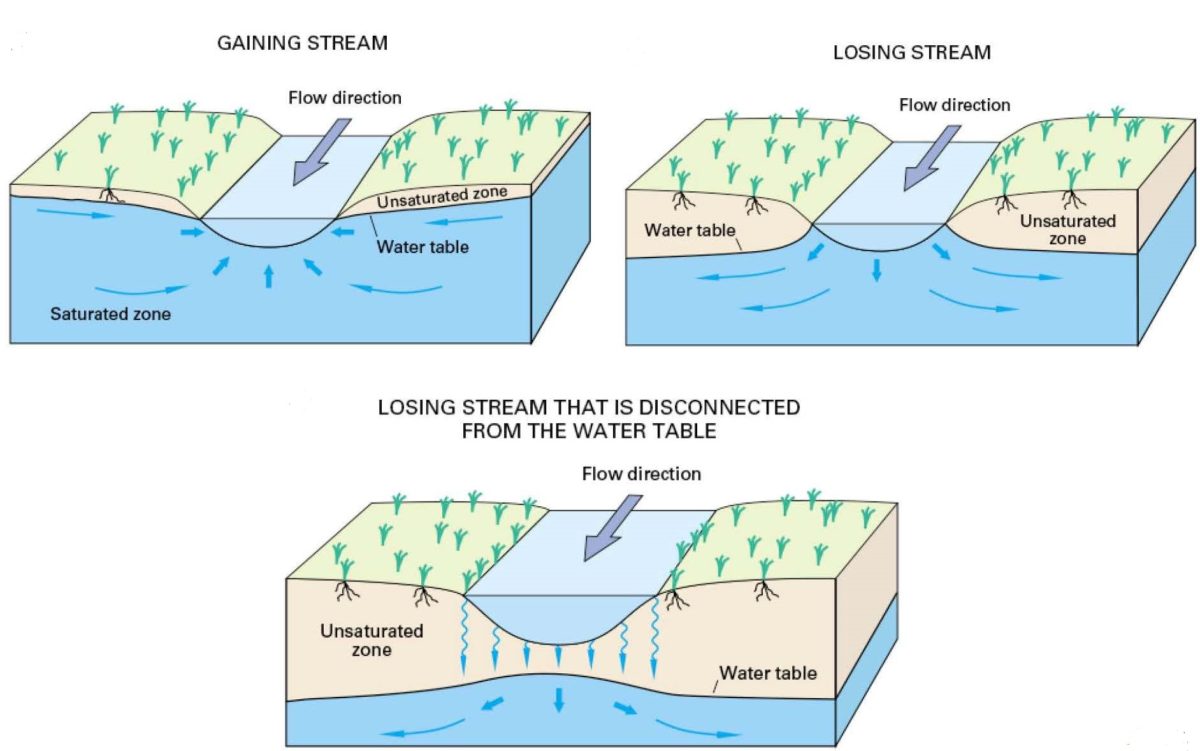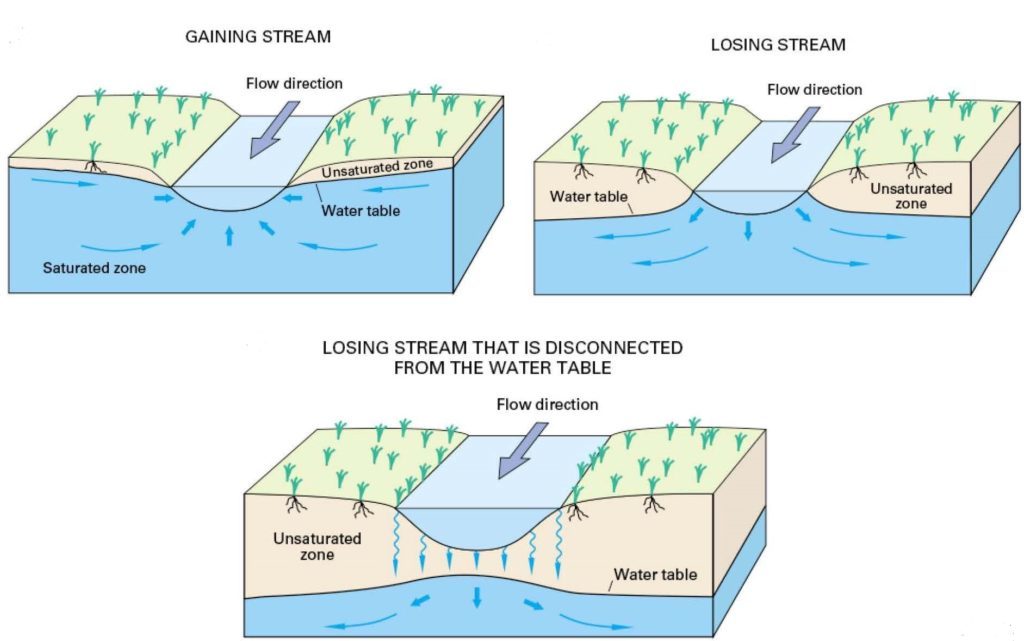 Though considered legally separate, groundwater and surface water are physically interconnected resources. SGMA recognizes this interconnection and requires that GSPs avoid “depletions of interconnected surface water that have significant and unreasonable adverse impacts”. Additionally, GSPs must consider impacts to groundwater-dependent ecosystems.
Though considered legally separate, groundwater and surface water are physically interconnected resources. SGMA recognizes this interconnection and requires that GSPs avoid “depletions of interconnected surface water that have significant and unreasonable adverse impacts”. Additionally, GSPs must consider impacts to groundwater-dependent ecosystems.
Lakes, wetlands, rivers, and other surface water bodies interact with groundwater in two main ways: surface water bodies “gain” or receive water from of the groundwater system or they “lose” or provide water to groundwater. The extent to which this exchange been surface water and groundwater systems occurs depends on the hydraulic gradient between systems.
In much of California, groundwater pumping has lowered the hydraulic gradient in these systems, such that surface water bodies largely lose water to underlying groundwater systems. A study by The Nature Conservancy in 2016 estimates that there is approximately 900,000 acre-feet less in the Sacramento River from groundwater pumping and other causes. However, in some groundwater basins the connection between these systems remains, providing support for plant and aquatic species particularly in dry months and years.
For more information, click here to visit the USGS webpage on Interconnected Surface Water Depletion.
Key information
FACT SHEET: Surface water depletions
SGMAInsert6SurfaceWaterDepletionReport: Navigating Groundwater-Surface Water Interactions under the Sustainable Groundwater Management Act
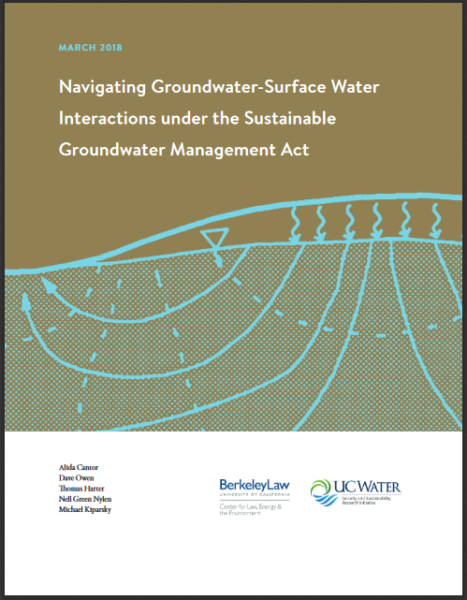 SGMA requires groundwater sustainability agencies (GSAs) to manage groundwater to avoid six undesirable results, including significant and unreasonable adverse impacts on beneficial uses of surface water. While this aspect of SGMA is clearly important, significant uncertainties exist regarding how GSAs will actually define and achieve this goal.
SGMA requires groundwater sustainability agencies (GSAs) to manage groundwater to avoid six undesirable results, including significant and unreasonable adverse impacts on beneficial uses of surface water. While this aspect of SGMA is clearly important, significant uncertainties exist regarding how GSAs will actually define and achieve this goal.
Addressing SGMA’s requirements for groundwater-surface water interactions will be difficult. Defining the issues at stake in any given basin, let alone successfully balancing the range of uncertainties and potentially conflicting interests, will pose challenges for many GSAs.
The research presented here examines some of the legal and institutional questions that will inevitably arise as GSAs seek to address groundwater-surface water interactions under SGMA. The core goal of this report is to help parties identify and address these questions, and ultimately to let GSAs and stakeholders manage groundwater-surface water interactions proactively and effectively.
Guide to Compliance with California’s Sustainable Groundwater Management Act: How to Avoid the “Undesirable Result” of “Significant and Unreasonable Adverse Impacts on Beneficial Uses of Surface Waters”
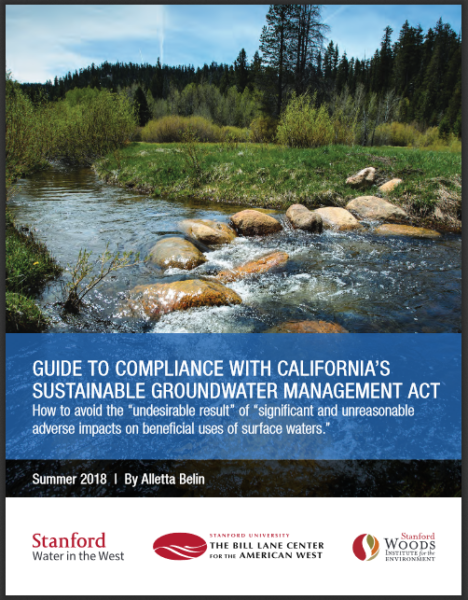 The purpose of this guide is to help GSAs and other stakeholders understand and comply with the requirement of SGMA that groundwater withdrawals must not cause “significant and unreasonable adverse impacts on beneficial uses3 of the surface water,” known as “undesirable result no. 6.”
The purpose of this guide is to help GSAs and other stakeholders understand and comply with the requirement of SGMA that groundwater withdrawals must not cause “significant and unreasonable adverse impacts on beneficial uses3 of the surface water,” known as “undesirable result no. 6.”
This guide is based on the principle that existing legal frameworks (laws, regulations, court decisions, etc.) provide the clearest and most pertinent guidance on what constitutes undesirable result no. 6. This guide addresses only the explicit legal aspects of this statutory mandate. It does not address technical and scientific aspects of SGMA compliance and offers no advice on the steps GSAs must take to get an adequate technical understanding of the groundwater-surface water connections under their purview.
Rivers that depend on aquifers: Drafting SGMA groundwater plans with fisheries in mind
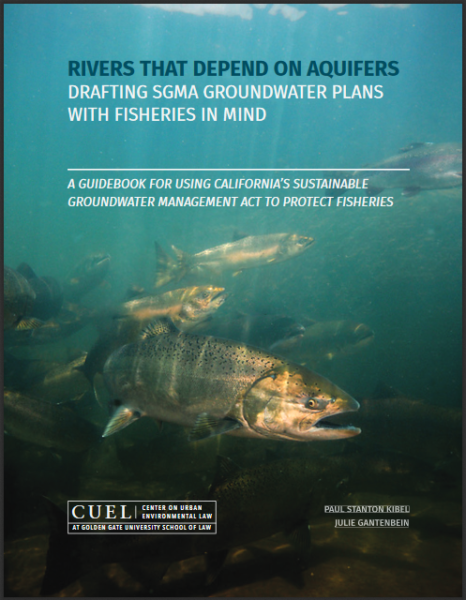 In California, surface waters have historically been regulated as if they were unconnected to groundwater. Yet in reality, surface waters and groundwater are often hydrologically connected. Many of the rivers that support fisheries such as salmon and trout are hydrologically dependent on tributary ground-water to maintain instream flow. This means that when there is intensive pumping of tributary groundwater the result can be reductions in instream flow and damage to fisheries.
In California, surface waters have historically been regulated as if they were unconnected to groundwater. Yet in reality, surface waters and groundwater are often hydrologically connected. Many of the rivers that support fisheries such as salmon and trout are hydrologically dependent on tributary ground-water to maintain instream flow. This means that when there is intensive pumping of tributary groundwater the result can be reductions in instream flow and damage to fisheries.
For this reason, stakeholders concerned about adequate instream flows for fisheries in California’s rivers, streams and creeks need to be effectively engaged in the implementation of California’s Sustainable Groundwater Management Act (SGMA).
Although groundwater sustainability agencies and fishery stakeholders recognize that the groundwater-surface water connection needs to be addressed in SGMA Groundwater Plans, at present there is limited guidance on how to do this. That is, what are the specific types of information, modeling, monitoring, and pumping provisions that should be included in SGMA Groundwater Plans to ensure that groundwater extraction does not cause significant adverse impacts on fisheries? The purpose of this guidebook is to provide such guidance.
Report: Groundwater and Stream Interaction in California’s Central Valley: Insights for Sustainable Groundwater Management
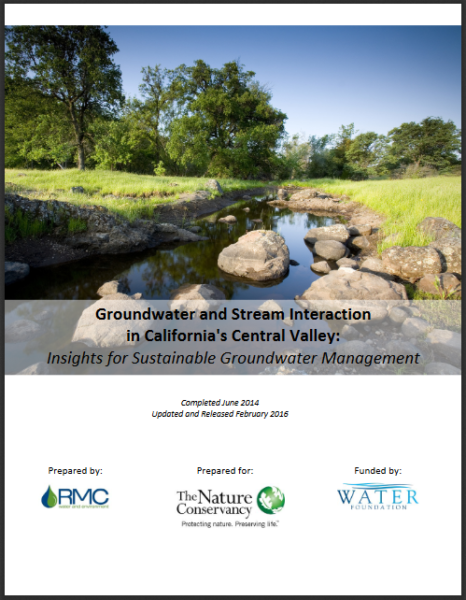 Groundwater is intimately connected to surface water, which has profound implications for sustainable water resource management. California has historically overlooked this important interaction and as a consequence, decisions about groundwater extractions have generally failed to address the resulting impacts to aquatic ecosystems such as rivers, wetlands and springs.
Groundwater is intimately connected to surface water, which has profound implications for sustainable water resource management. California has historically overlooked this important interaction and as a consequence, decisions about groundwater extractions have generally failed to address the resulting impacts to aquatic ecosystems such as rivers, wetlands and springs.
This study models the historical impacts of groundwater use on groundwater levels and stream flow conditions in California’s Central Valley. The results illustrate how rivers and streams that historically gained surface flows from groundwater now lose surface flows to groundwater.
Addressing regional surface water depletions: A proposed approach for compliance with SGMA
From the Environmental Defense Fund:
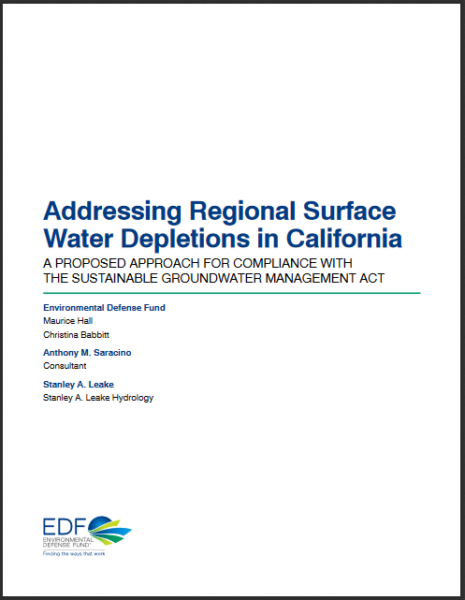 Successful implementation of the Sustainable Groundwater Management Act (SGMA), including its provision to avoid significant and unreasonable depletion of interconnected surface water, is a high priority for the Environmental Defense Fund (EDF). The lack of established mechanisms for addressing depletions of interconnected surface water makes the implementation of this aspect of SGMA especially challenging. Accordingly, EDF offers recommendations to address the requirements of the law related to depletion of interconnected surface water, commonly referred to as “Undesirable Result No. 6” (UR #6).
Successful implementation of the Sustainable Groundwater Management Act (SGMA), including its provision to avoid significant and unreasonable depletion of interconnected surface water, is a high priority for the Environmental Defense Fund (EDF). The lack of established mechanisms for addressing depletions of interconnected surface water makes the implementation of this aspect of SGMA especially challenging. Accordingly, EDF offers recommendations to address the requirements of the law related to depletion of interconnected surface water, commonly referred to as “Undesirable Result No. 6” (UR #6).
We propose an approach that we believe provides a reasonable balance among the conflicting factors of rigor, cost, uncertainty, and enforce-ability that weigh on the implementation of this requirement. Our goal is to offer a pathway to achieve the fundamental and critical objective of UR#6, which aims to prevent significant impacts to water users and ecosystems that depend on streams and rivers that may be depleted by groundwater withdrawals, in a way that is not unreasonably costly or unproductively burdensome on the Groundwater Sustainability Agencies (GSAs), water users, and state agencies who will bear most of the burden of complying with—or ensuring compliance with—SGMA.
USGS: Streamflow Depletion by Wells—Understanding and Managing the Effects of Groundwater Pumping on Streamflow
circ1376_barlow_report_508Featured Tools
Natural flows database
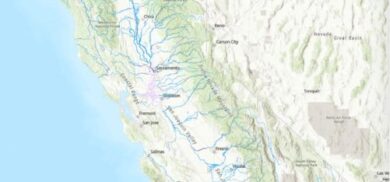 Groundwater Sustainability Agencies interested in establishing measurable objectives that can protect instream flow needs can now access the Natural Flows Database – a new tool predicting natural flows across California. These predictions include monthly flow and functional flow metrics that represent aspects of the annual flow variation that directly relate to ecological, geomorphic or biogeochemical processes in rivers and streams (e.g., wet-season peak flow, dry-season base flow). The functional flow metric predictions are part of the California Environmental Flows Framework (CEFF), a statewide approach to develop stream segment-scale ecological flow criteria that protect native aquatic species and communities.
Groundwater Sustainability Agencies interested in establishing measurable objectives that can protect instream flow needs can now access the Natural Flows Database – a new tool predicting natural flows across California. These predictions include monthly flow and functional flow metrics that represent aspects of the annual flow variation that directly relate to ecological, geomorphic or biogeochemical processes in rivers and streams (e.g., wet-season peak flow, dry-season base flow). The functional flow metric predictions are part of the California Environmental Flows Framework (CEFF), a statewide approach to develop stream segment-scale ecological flow criteria that protect native aquatic species and communities.
ICONS dataset
![]() The ICONS dataset provides information on the depth to groundwater and the likely presence of interconnected surface water (ISW) in the Central Valley. When surface water in rivers and streams is connected to groundwater through a continuously saturated zone, this is called ISW. With ISW, any excessive pumping of groundwater can reduce the surface water supply, impacting nearby vegetation and ecosystems. By understanding this link between surface water and groundwater, and by knowing the locations of likely ISW, groundwater sustainability agencies (GSAs) can better manage their local water resources.
The ICONS dataset provides information on the depth to groundwater and the likely presence of interconnected surface water (ISW) in the Central Valley. When surface water in rivers and streams is connected to groundwater through a continuously saturated zone, this is called ISW. With ISW, any excessive pumping of groundwater can reduce the surface water supply, impacting nearby vegetation and ecosystems. By understanding this link between surface water and groundwater, and by knowing the locations of likely ISW, groundwater sustainability agencies (GSAs) can better manage their local water resources.
Groundwater-surface water interaction articles at Maven’s Notebook
- Notebook groundwater-surface water interaction

Explore groundwater-surface water interaction at the California Water Library
{{ document.post_title }}
{{ document.publisher }} | {{ document.document_date }}
{{ document.post_content_short }}

